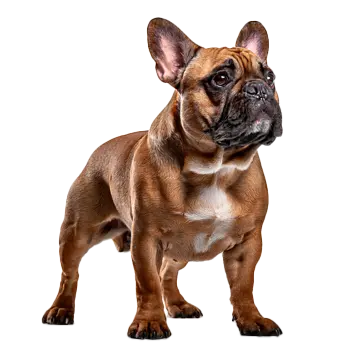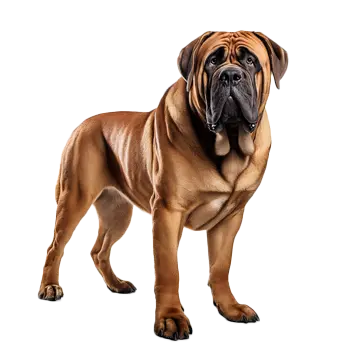French Masti-Bull
Hybrid Breed Description
The French Masti-Bull is a cross between the French Bulldog and the Mastiff. Because each hybrid inherits a unique combination of traits from both parents, we recommend thoroughly researching both breeds before choosing a French Masti-Bull. Pay special attention to temperament, health issues, and care requirements, as your dog may express characteristics from either parent breed.
French Bulldog

French Bulldogs are compact yet muscular dogs with a distinctive appearance that makes them instantly recognizable. Males typically weigh between twenty to twenty-eight pounds, while females range from sixteen to twenty-four pounds, with both sexes standing approximately eleven to twelve inches tall at the shoulder. Their most notable feature is the large bat-shaped ears that stand erect, combined with a flat skull between the ears and a domed forehead that creates their characteristic expression. The breed possesses a square, heavy head with a short muzzle and pronounced facial wrinkles, along with a black mask around the eyes and nose. The body structure is stocky and muscular despite the small size, with a broad chest reaching at least to the elbows and well-sprung ribs. Their coat is short, smooth, and fine to the touch, requiring minimal grooming. Standard colors include fawn, white, cream, brindle, and various combinations of these shades. The breed features small, dark eyes that are set wide apart, and their distinctive body proportions give them a unique, almost hunchbacked appearance due to the slight roach back from shoulders to tail. French Bulldogs have short, sturdy legs set wide apart on the front, with hind legs that are slightly longer and stronger. The tail is naturally short and can be either straight or corkscrew-shaped, set low on the body. Their overall build reflects their bulldoglike heritage while maintaining a compact, manageable size ideal for companionship.
Key Characteristics
French Bulldogs exhibit a playful, adaptable, and affectionate temperament that has made them one of the most popular companion breeds worldwide. These dogs are characterized by their even-tempered, friendly nature and remarkable patience, particularly with families. They thrive on human attention and form deep bonds with their owners, often displaying a strong desire to be the center of attention and receive constant affection. Their sociable personality makes them excellent companions for various household types, from singles to families with older children. Despite their small size, French Bulldogs possess considerable intelligence and can be quite clever, though they also exhibit a notable stubborn streak. Training requires patience, consistency, and positive reinforcement methods, as they respond poorly to harsh corrections. They have relatively low to moderate energy levels and don't require extensive exercise, making them well-suited for apartment living. However, they remain alert and make surprisingly good watchdogs, barking only when they find genuine cause for excitement. Their calm demeanor indoors contrasts with occasional bursts of playfulness, and they're known for their entertaining, clownish behavior that keeps families amused. French Bulldogs are generally gentle and non-aggressive, though proper socialization from puppyhood is essential to ensure they develop appropriate behaviors around strangers and other animals. They can be somewhat territorial and may compete for attention in multi-pet households. Their need for companionship means they don't tolerate being left alone for extended periods well, and they prefer spending time indoors with their families rather than being outdoor dogs. The breed's friendly disposition extends to most people and pets they encounter, though they maintain a dignified independence that reflects their unique personality.
French Bulldogs face numerous health challenges primarily related to their brachycephalic anatomy and genetic predispositions. Brachycephalic Obstructive Airway Syndrome is the most serious concern, encompassing narrow nostrils, elongated soft palate, and potential laryngeal collapse that severely restricts breathing. This condition makes Frenchies highly susceptible to overheating, particularly in hot or humid weather, and limits their exercise tolerance. Many dogs require corrective surgery to improve their breathing capacity, though this comes with risks due to the breed's sensitivity to anesthesia. Orthopedic issues are common in French Bulldogs, including hip dysplasia affecting over twenty percent of the breed, and intervertebral disc disease due to their compact spinal structure. Patellar luxation, where the kneecap slips out of position, occurs frequently and may require surgical intervention. The breed also suffers from various spinal malformations, particularly hemivertebrae, which can lead to neurological problems and mobility issues. Joint problems often develop early and progressively worsen without proper management through weight control and appropriate exercise. Skin conditions plague the breed due to their characteristic facial and body folds, which can develop dermatitis and infections without regular cleaning. Food and environmental allergies are extremely common, manifesting as itchy skin, ear infections, and gastrointestinal problems. Eye issues including corneal ulcers and cherry eye occur frequently due to their prominent eye position. French Bulldogs have a relatively short lifespan of ten to fourteen years, with many dogs experiencing multiple health conditions throughout their lives. Reproductive challenges are significant, with most females requiring cesarean sections for safe delivery. Regular veterinary care, weight management, and avoiding temperature extremes are essential for maintaining their health and quality of life.
Mastiff

Mastiffs are among the largest and most imposing dog breeds in the world, with males typically standing thirty to thirty-three inches tall at the shoulder and weighing between one hundred sixty to two hundred thirty pounds, while females measure twenty-seven and a half to thirty inches tall and weigh one hundred twenty to one hundred seventy pounds. Some exceptional individuals have exceeded three hundred forty pounds, making them true giants of the canine world. Their massive size is accompanied by a powerful, muscular build with heavy bone structure throughout their bodies, creating an impressive and commanding presence. The breed features a large, square head that is heavy and broad, with a short muzzle approximately half the length of the skull. Their distinctive facial features include pronounced wrinkles across the forehead, drooping jowls, and a black mask around the eyes and nose that contrasts with their coat color. The eyes are small, dark hazel or brown, set wide apart and expressing a gentle demeanor despite the dog's imposing size. Small, V-shaped ears hang down to frame the cheeks when at rest, positioned high and wide on the skull. Mastiffs possess a rectangular, compact body with a broad, deep chest that extends at least to the elbows and well-sprung ribs that provide ample room for their organs. The back is relatively short with a slight arch, and the tail is set moderately high, hanging straight down to the hocks when relaxed. Their legs are straight and sturdy, with large feet that support their massive frame. The coat is short, dense, and straight with a coarse texture that lies close to the body. Standard colors include fawn, apricot, and brindle, always with the characteristic dark mask. Despite their size, well-conditioned Mastiffs move with surprising grace and power, displaying a smooth, coordinated gait.
Key Characteristics
Mastiffs are renowned as gentle giants, combining their impressive physical presence with a remarkably calm, dignified, and affectionate temperament. These dogs are characterized by their deep loyalty to family members and their patient, loving nature that makes them excellent companions for households with older children. They form strong bonds with their families and thrive on human companionship, often attempting to be lapdogs despite their enormous size. Their even-tempered disposition is complemented by a natural protectiveness that stems from centuries of guarding heritage, though they express this through intimidating presence rather than aggressive behavior. The breed displays an inherent protective instinct that manifests as vigilance toward strangers and wariness of unfamiliar situations. Mastiffs tend to be reserved and aloof with people they don't know, carefully observing before deciding whether to approach. Despite their guardianship tendencies, they bark infrequently, preferring to use their imposing size as a deterrent. Early and extensive socialization is crucial to ensure they develop appropriate responses to new people and situations, preventing excessive suspicion or fearfulness. When properly socialized, they remain calm and controlled, able to distinguish between genuine threats and normal household activities. Mastiffs are surprisingly low-energy dogs that enjoy a relaxed lifestyle, making them excellent companions for those seeking a calm household presence. They require moderate exercise but are often content with short walks and indoor time with their families. Their intelligence allows them to learn quickly, though training should be approached with patience, gentleness, and positive reinforcement, as they are sensitive dogs that respond poorly to harsh methods. They can display stubbornness at times, requiring consistent but kind handling. Mastiffs suffer from separation anxiety when left alone for extended periods, emphasizing their need for regular human interaction. Their affectionate nature, combined with their protective instincts and gentle demeanor, makes them ideal family guardians and devoted companions for those who can accommodate their size and care requirements.
Mastiffs face significant health challenges that are largely attributable to their massive size and genetic predispositions, resulting in one of the shortest lifespans among dog breeds at just six to ten years. Cancer is the leading cause of death, affecting nearly half of all Mastiffs, with osteosarcoma being particularly prevalent. The rapid growth during puppyhood and the strain of supporting their enormous body mass throughout life contribute to premature aging and increased stress on all organ systems, particularly the joints and cardiovascular system. Orthopedic problems are extremely common in Mastiffs, with hip and elbow dysplasia affecting over twenty percent of the breed population. These conditions occur when joints develop improperly, leading to painful arthritis and mobility issues that worsen with age. The breed is also prone to panosteitis during growth phases, causing painful inflammation in the long bones, and wobbler syndrome, a neurological condition affecting the cervical spine that results in an unsteady gait. Maintaining a healthy weight through controlled feeding and appropriate exercise is crucial, as obesity exacerbates all joint and skeletal problems. Gastric dilatation-volvulus, commonly known as bloat, represents a life-threatening emergency particularly common in deep-chested giant breeds like Mastiffs. This condition requires immediate veterinary intervention and many owners elect to have preventive surgery performed. Heart disease, including dilated cardiomyopathy and pulmonic stenosis, affects the breed at higher rates than average, with some dogs dying within three years of diagnosis. Additional concerns include progressive retinal atrophy leading to blindness, epilepsy with difficult-to-control seizures, hypothyroidism affecting metabolism, and various eye problems including entropion and ectropion requiring surgical correction. The breed's brachycephalic features make them susceptible to overheating, requiring careful temperature management. Regular veterinary monitoring, appropriate nutrition formulated for giant breeds, controlled exercise during growth, and proactive health screening are essential for maximizing the Mastiff's quality of life and longevity.
Important to Remember
Each hybrid dog is unique and may inherit any combination of traits from either parent breed. The information above represents the characteristics of the purebred parent breeds. Your French Masti-Bull may favor one parent over the other or display a blend of both. We strongly encourage you to read the complete breed profiles for both the French Bulldog and Mastiff to fully understand the range of possible temperaments, health concerns, and care requirements.